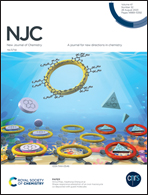MIL-101(Fe)@Nb2C MXene for efficient electrocatalytic ammonia production: an experimental and theoretical study†
Abstract
The environment-friendly electrochemical nitrogen reduction reaction (NRR) is considered to be a promising alternative to the traditional Haber–Bosch process for ammonia production. However, the stability of nitrogen and competitive hydrogen evolution reaction (HER) lead to low faradaic efficiency (FE) and ammonia selectivity for the NRR. Compared with the NRR, the electrochemical nitrate reduction reaction (NO3RR), with no process of N2 adsorption, exhibits a higher NH3 yield and FE. In this work, the MIL-101(Fe) is synthesized and composited with Nb2C MXene, which exhibited excellent NRR and NO3RR performance. For the NRR, the MIL-101(Fe)@Nb2C achieved an ammonia yield of 8.92 μg h−1 cm−2 and a high FE of 20.77%. Meanwhile, for the NO3RR, it achieved a large NH3 yield of 199.68 μg h−1 cm−2 and a high FE of 89.9%. In addition, MIL-101(Fe)@Nb2C exhibits excellent stability for the NRR and NO3RR. DFT calculations proved that the interfacial interaction between Nb2C and MIL-101(Fe) acquired a significant synergistic mechanism to improve the catalytic performance. Since the NH3 yield and FE of the NO3RR are much higher than those of the NRR, it is vital to design NRR catalysts that can easily adsorb and activate nitrogen as well as inhibit the HER.



 Please wait while we load your content...
Please wait while we load your content...